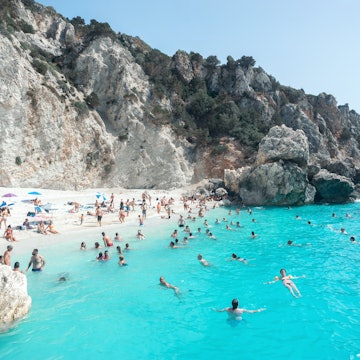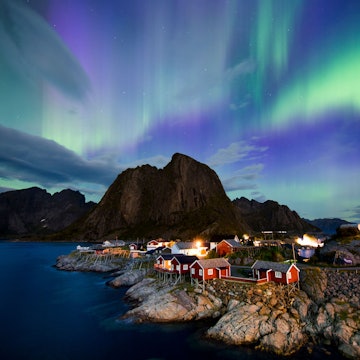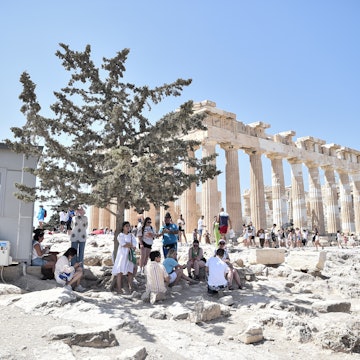
The best times to visit Finland: from the northern lights to the midnight sun

May 16, 2022 • 10 min read

From the beautiful colors of fall to the wildflowers in spring, here's what's happening through the year in Finland © SakariLampola / Getty Images
Luring outdoor enthusiasts, design buffs, and curious souls wishing to crack the secrets behind its UN-bestowed accolade of the world’s happiest country, Finland is a destination whose tourist attractions are nearly as diverse as its climate.
This tract of Scandinavia hosts the midnight sun in summer and the polar night in winter. Lapland, home of the indigenous Sámi people, is covered in snow for up to eight months a year, making it a snowsports destination par excellence. It’s also one of the best places in the world to observe the eerily beautiful phenomena of the aurora borealis, also known as the northern lights.
But in the southwest of the country, the Åland Archipelago has the distinction of being the sunniest spot in Northern Europe and so is a popular destination for beach holidays. Between these two regions are cosmopolitan cities, quaint villages, and pristine natural landscapes that shine at different times of the year. This month-by-month guide to climate and events can help you choose the best time for your visit to Finland.
Head to Lapland in high season (December to April) for winter sports and icy adventuring
This is high season in Lapland, with the main draws being family visits to Santa Claus’ Village in Rovaniemi, sensational snow sports, reindeer racing, overnight stays in whimsical snow hotels, and the extraordinary phenomenon of the northern lights. Resorts and hotels are crowded and expensive around Christmas, during the four-day Easter break, and throughout the ski season, which kicks off in mid-February.
Between December and January the phenomenon of the polar night means that the sun never rises inside the Arctic Circle. In northern Lapland, the closest the sun gets to rising is around midday, when the horizon glows with rich colours for a few hours, bathing the landscape in an ethereal beauty.
The best months for skiing and other adventure sports are from February to April, when the sun has re-emerged after its two-month winter hibernation and the snowy expanses of countryside glisten and gleam.
In the south and center of the country, the winter days are short, with only six hours of light per day in December. Cross-country skiing is popular from February, when the days start to get longer. Ski resorts are crammed with Finns in March and April, particularly during Easter and on weekends – book in advance and expect high-season prices.
Ice and sleet make road conditions treacherous at this time of the year – be very careful if you’re driving.
Your chances of viewing the northern lights in Lapland are high during March and April. Down south, sightings are considerably less frequent.

Make the most of white nights from May to mid-August
The summer season kicks off on May Day (May 1) and the midnight sun asserts itself from the end of May to the end of July, reducing night-time darkness to five or six hours at most. In Lapland’s far north, the sun doesn’t set at all from mid-May to late July. Daytime temperatures range between 15–25°C (59–77°F) in the south and 10–15°C (50–59°F) in Lapland; the warmest conditions are on the southwestern archipelago.
Finns make the most of these warm days and white nights, enjoying outdoor activities including hiking, biking, canoeing, and swimming during the day and winding down over drinks and long dinners into the wee small hours. There are music festivals to attend, scenic boat cruises to enjoy, and plenty of lakes in which to plunge after spending time in a steamy sauna.
July is the busiest month on the coast and around lakes, as this is when Finns tend to enjoy their annual holidays. Expect crowds and high hotel prices if you decide to join them.
Summer showers are relatively frequent in the interior during July and August, but conditions on the coast are drier, with clear skies and plentiful sunshine.
Enjoy forest hikes and aurora spotting from mid-August to November
Summer days dwindle and autumn arrives alongside the ruska-aika (russeting), when Finnish forests are ablaze with colored leaves signalling the change of season. This is a marvellous time to go hiking or cycling – the colours turn in Lapland in September before putting on a show in the south a few weeks later.
The first snow falls in the north in late September and winter storms are common in November. Outside cities, many tourist attractions and hotels close from October until the start of summer.
In Lapland, the northern lights make regular appearances throughout October and November.

When can I see the northern lights?
The extraordinary natural phenomenon known as the aurora borealis, or northern lights, is best witnessed in Lapland, particularly north of the Arctic Circle. Here, the skies are clear of light pollution and is dark and cloudless for months on end, maximizing the chance of seeing these auroral displays in all of their swirling technicolor majesty. The spring and autumn months are the optimal viewing times, especially October, November, March, and early April. For more information, see the Finnish Meteorological Institute’s website.
It's really cold in January, perfect for arctic adventuring
It’s cold in January. Really cold. So those travelers who head this way are usually on a mission to experience an arctic adventure. In Lapland, you can overnight in a fairytale-like ice hotel hewn from the ice, embark on an action-packed snowmobile safari, or glide across moonlit landscapes on a sled pulled by huskies or reindeers. Go in the second half of the month, when the sun starts to reappear, but make sure you dress for temperatures as low as -35°C (-31°F).
February is the start of the ski season
The sun slowly starts to exert itself and as daylight hours increase so too do the number of cross-country skiers exploring the snow-covered countryside in the south of the country before heading north in March and April. The ski resorts across the country are busy from the middle of February and their accommodation prices stay high from this point until the end of the Easter holiday.
Keep an eye out for the northern lights in March
Spring tends to arrive with a whimper rather than a bang, staying cold and often snowy. Days are getting longer, though, so it’s a great time to enjoy snow sports. Temperatures start to nudge above 0°C (32°F) in the north and Lapland’s famous reindeer racing season culminates in the Poro (Reindeer) Cup, held on the ice in Inari, the capital of Sámi culture. The spring equinox on March 21 is generally agreed to be the optimum time for viewing the northern lights. Temperatures can vary greatly between night and day – pack appropriately.
Key event: Poro Cup (late March or early April).
April means the return of weak sunshine
The snow disappears in the south and the sunshine makes a welcome, albeit weak, reappearance. There’s still plenty of snow in the north, and Lapland’s ski resorts are often packed to the gills over the four-day Easter holiday. On the Saturday or Sunday before the Easter break, young Finnish children (especially girls) dress up as witches, carry willow twigs and visit houses in their neighborhoods, offering blessings in exchange for sweet treats.
Key event: Pääsiäinen (Easter).
Celebate spring and the midnight sun in May
One of Finland’s major national holidays, Vappu, is celebrated on May 1. Marking the end of winter, its inevitably boozy events tend to kick off on the night before, when bars and restaurants across the country are at their boisterous best. In Southern Finland, spring wildflowers bloom in meadows, birds migrate north, and hikers hit national park trails from late May. Helsinki and other cities are at their vibrant best. The midnight sun reigns over Lapland from mid-May, with melting snow and 24hr sunlight.
Key event: Vappu.

June is party time
Summer brings festivals and cultural events aplenty, including the biggest of them all, Juhannus (Midsummer). Celebrated on the Saturday between June 20 and 26, Finns welcome the midnight sun with lakeside bonfires, cooking, drinking and plenty of sauna action. Cities are quiet in the days around Juhannus, and many businesses close. Other events include Jutajaiset, a three-day celebration of Lapland’s folklore, and the five-day Midnight Sun Film Festival in the northern city of Sodankylä. Conditions in Lapland are muddy, so not ideal for outdoor adventures, but in the south hiking, cycling, and canoeing are popular activities from mid-June.
Key events: Juhannus, Jutajaiset, Midnight Sun Film Festival.
There are popular festivals in July
When summer hits its stride the Finns hit the water. July is when most locals take their annual holidays, and accommodations on the coast or near lakes are fully booked months in advance. It’s also expensive. Temperatures range from 17°C (62°F) to 26°C (79°F) and this balmy weather brings with it mosquitos and midges, especially in Lapland – make sure you carry heavy-duty repellent. Popular cultural events include the world-famous Savonlinna Opera and Pori Jazz festivals.
Key events: Savonlinna Opera Festival, Pori Jazz, Kaustinen Folk Music Festival, Ruisrock.

August means fewer people
The summer living continues to be easy. School holidays finish in the middle of the month and a blessed calm falls upon lakeside and coastal areas. Temperatures are benign and there are plenty of opportunities for crowd-free hiking, biking, swimming, boating, and fishing. Although most businesses stay open, the price of accommodations drop. In Lapland the mosquito threat lessens but the midnight sun disappears, heralding the first snowfalls on the fells.
Key event: Helsinki Festival.
Fall colors are spectacular in September
Few Finnish sights are as splendiferous as the ruska-aika, when the advent of frost prompts foliage to turn gold, orange, bronze, yellow and crimson. Colors last for a couple of weeks in Lapland and then reoccur further south later in the month and into October, providing a wonderful backdrop when hiking or cycling in national parks. The autumn equinox occurs on September 21 and from then the days become shorter every day until Christmas. Most coastal sights and attractions close or adopt reduced hours from the middle of the month onwards.
Key event: Sibelius Festival (Lahti).
October is one of the best times for the aurora borealis
The sun has disappeared in Lapland but compensation comes in the form of the northern lights. Your chances of seeing these in October are excellent, and accommodation and flight costs are cheaper than in the winter months because the ski season hasn’t yet kicked off. The rest of the country is easing into its winter hibernation, and many tourist attractions are closed.
November marks the start of snow sports
Winter storms, cold arctic winds, and shortened daylight hours make November a somewhat gloomy month, one that many travelers may wish to avoid. The official ski season kicks off late in November, although some resorts in Lapland have snow-covered slopes earlier in the month.
December is for visiting Santa
By December, most of the Finnish countryside is covered with snow and daylight hours are meagre or non-existent. The powdery-white landscape is picture-book pretty but too cold to explore on foot – take to skis or snowboard instead. Late in the month families descend on Lapland en masse, lured by the chance to meet Santa Claus in his official village in Rovaniemi – aim to arrive early in the month before Finnish school holidays begin if you are keen to beat the crowds.
Elsewhere, Finns keep themselves entertained by steaming in saunas, imbibing copious quantities of glögg (hot spiced mulled wine) and celebrating Itsenäisyyspäivä (Independence Day) on December 6 with processions, fireworks and concerts.
Key event: Itsenäisyyspäivä, Joulu (Christmas).
You might also like:
How to visit Finland on a budget (the only guide you’ll ever need)
Finnish-ing touches: all you need to know before your trip to Finland
9 incredible remote escapes in Europe for 2022















